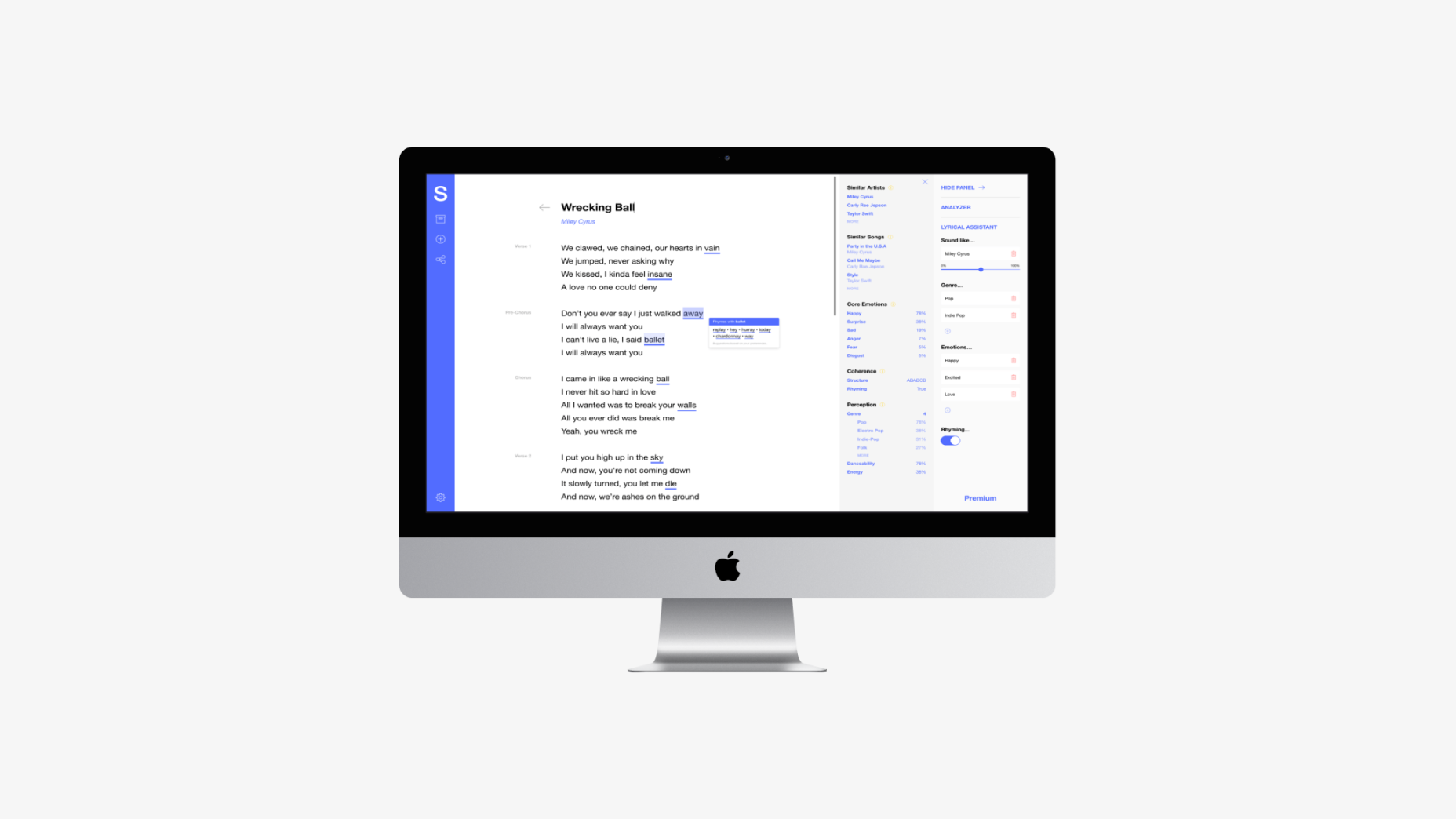Background
Simile was a final project for 05-317, The Design of Artificial Intelligence Products, in the Human-Computer Interaction Institute at Carnegie Mellon University. Students were tasked to envision a novel product or service that employs natural language processing (NLP) technology. My team created an NLP lyric analysis tool to help aspiring musicians and songwriters craft and revise their song lyrics.
Overview
Students were tasked to envision a novel product or service that employs natural language processing (NLP) technology. Using a matchmaking process and a competitive analysis, we narrowed 20 initial ideas down to one value-focused NLP system for a specific set of target users. Ideation process includes finding and/or constructing an appropriate dataset(s) for inferences, accounting for inference errors, and prototyping to our greatest risk.
Defining Basics
Goal
Assist the songwriting process by analyzing lyrics to help aspiring musicians and songwriters craft and revise their songs.
User Value
Enhances creativity, makes better lyrical choices, more attractive songs, better understanding of own musical choices
Service Value
Better insight into artists across time, genres, platforms, etc.
Difficulty
Moderate
Concept Exploration
Preliminary Concept Testing
We sent a survey to musicians to gauge interest in a tool that helps with song writing.
- 9 responses (5 men and 4 women)
- Ages 18-34
- All practicing musicians
Insights
What we learned
- Originality is a priority
- There is sufficient interest in a tool that would suggest (in-line) or generate lyrics based on a set of features
- Features of interest: artist likeness, sounds phonetically good, mood/ sentiment
What that means
Nearly every musician struggles with writing lyrics. If we can create a tool that doesn't interfere with the creative process, but provides valuable analytics and recommendations when writers are stuck, they may be willing to pay for this kind of support.
Persona
Mark...
- is a budding performer and songwriter.
- struggles with generating the right words to match the music he creates.
Mark wants to finish creating lyrics for a song but...
- has writer's block.
- doesn't have time to think of potential combinations of words that rhyme, make sense, and sound good
NLP System
Using the One Million Songs dataset, we could create a comprehensive dataset for our NLP tool with difficult labels already generated. This makes the feasibility of our idea low to moderate.
Our primary difficulty for song analysis then becomes a classification task of labeling user-generated lyrics. Our generation tool can suggest lyrics other artists would use and detect emotion using common sentiment analysis and emotion detection algorithms.
Dataset
Pre-labeled data from the One Million Songs dataset includes… Artist name, song name, lyrics, album, terms, genre, sections, loudness, tempo time signature, key, energy, danceability, segment timbre, duration, similar artists, start/end times for segments, etc.
Figures
- 1,000,000 songs/files (273 GB of data)
- 515,576 dated tracks starting from 1922
- 44,745 unique artists
- 2,201,916 asymmetric similarity relationships
- 43,943 artists with at least one term
- 7,643 unique terms (Echo Nest tags)
- 2,321 unique musicbrainz tags
Wireframes
We started by exploring what musicians might want to control in an interface.
However, we gradually gravitated towards focusing primarily on the writing itself, very similar z the correctional grammar tool, Grammarly. We wanted to provide artists with a clutter-free writing space with the NLP lyrical tool readily accessible. Our interface is collapsible, with multiple views.
Paid users can access additional, generative features which provide in-line suggestions for rhymes and words that suit their lyrical criteria with lyrical suggestions based on genre, emotion, and phonetic rhyming. For example, an artist could look for words similar to those Taylor Swift uses in her songs, words that rhyme, or other words frequently used in pop music in context of his or her song.
Risk & Error Recovery
- Inappropriate or offensive content recommendations
- Artists can toggle censorship of expletive words
- Artists can flag inappropriate content
- Unhelpful or uninspiring
- Nonsensical suggestions in the creative process for songwriting are low-risk
- Poor suggestions are low-risk unless consistently poor
- Suggesting similar content to multiple users
- Users can take what they want from suggestions
- Songs will likely still remain quite different; we can flag cover songs
Final Prototype
Reflection
We received valuable feedback from musicians, peers, and instructors from surveying musicians and three in-class presentations, pivoting from the patent application process to songwriting. Feedback was positive and helped us refine a viable prototype for our greatest risk and challenge—adoption.
Musicians voiced interest in using a lyrical tool, but have various opinions on payment. Figuring out how to accommodate for the variety of responses and create a viable business model proved difficult. We subsequently addressed this ambiguity by creating a freemium model separating analytical from generative features of NLP.
Feedback from the class expressed concerns over how significantly NLP will improve the creative writing process from a simple rhyming dictionary, and what additional capabilities might be necessary to increase adoption. We used this to define other capabilities that would make such a tool convenient in more just lyric generation, and a roadmap for hooking in our target audience early on in their careers as budding musicians.
For information about other AI-based projects from this class, please email me.
